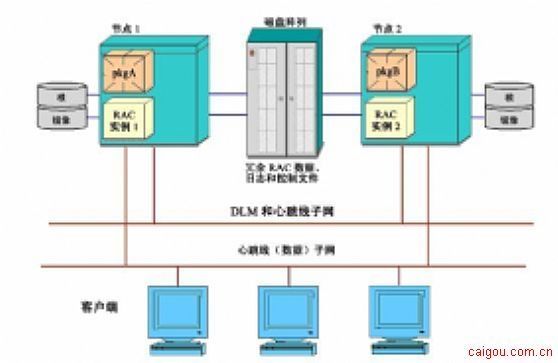The current mainstream clustering methods include the following:
1. Server active and standby cluster
The server's main-standby mode is provided by a server in the normal operating state to provide external services, other cluster nodes as backup machines, the backup machine does not accept external application requests under normal conditions, real-time detection of the production machine, only when the production machine is down Will take over the application service, so the equipment utilization rate can reach up to 50%. The main-standby cluster is shown in the following figure. Node 2 is a server that provides services normally. It runs multiple applications (pkgA, pkgB ..). Node 1 usually monitors the status of node 2 only, and does not provide services to the outside. At this time, Node 1 will take over the two applications and provide external services.
2. Server mutual backup cluster mode
Multiple servers form a cluster. Each server runs an independent application and serves as a backup for other servers. When the main application is interrupted, the service will be taken over by other cluster nodes. The node that takes over the service will run its own application and the application of the failed server. In this way, the hardware resources of each cluster node can be applied to external services. The cluster in the mutual standby mode is shown in the following figure. Node 1 and node 2 run one or more different applications, but only provide local main applications. The two nodes monitor each other, and any node in the cluster fails. After that, another node takes over the main application of the failed node, and all application services are completed by one server.
The main disadvantages of this approach are:
? Due to the need to restart the database core process, the database system cannot be guaranteed to run continuously
? In the process of system switching, the database connection between the client and the server will be interrupted, and the database connection and login work need to be re-established
? Since the database system can only run on one server, the other server cannot share the load of the system, which actually causes a waste of customer investment. In some systems, in order to solve the problem of dual-machine load sharing, the application system is artificially divided into two database systems, which are run on two servers. This approach solves the problem of load sharing to a certain extent, but it brings a lot of additional complexity to business processing such as system management and statistical analysis.
3. Server parallel cluster mode
The cluster is composed of multiple servers, and provides the same application at the same time, which can achieve load balancing among multiple servers and provide application requirements for large amounts of access, such as Web access and database applications. The server parallel clustering method is generally determined by the application system itself ( Such as OracleRAC, middleware load balancing, etc.) or external dedicated server load balancing equipment.

A stationery item used to protect documents.Inside pages are typically 20, 30, 40, 50 pages, with single pockets and double pockets.The size of the brochure is generally A4, but also B5.Cover is generally PP, plus a variety of printing patterns.There is a built-in information card in the middle, which can be handwritten notes.General use in schools and offices

Display Books,Plastic Display Book,Solid Cover Display Book,Display Clear Book
shaoxing chaofeng stationery manufacturing CO.,LTD. , https://www.chaofengstationery.com